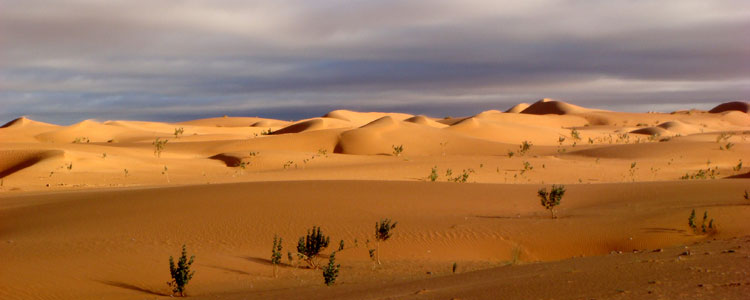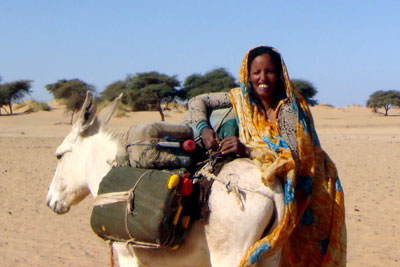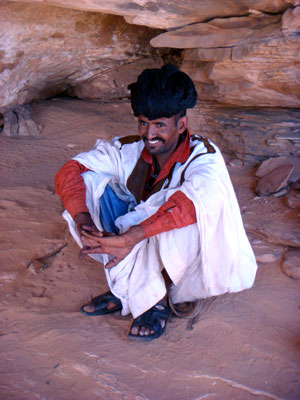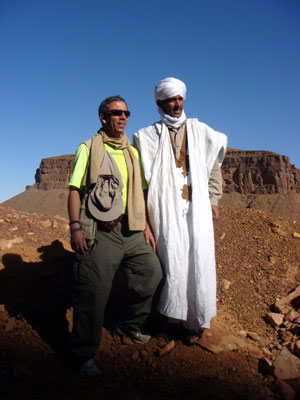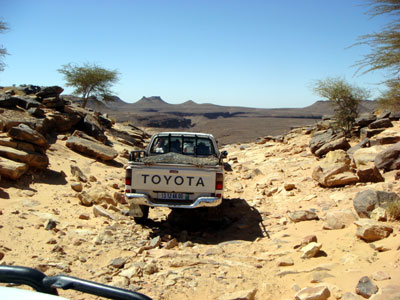From island to desert — an exciting journey through Senegal and Mauritania
by Harriet Hughes, Alexandria, VA
In February 2010 I toured Senegal and Mauritania with Spiekermann Travel (Eastpointe, MI; 800/645-2323). The food was good and the weather great, and our small group had a wonderful time exploring these two off-the-beaten-path countries.
Getting started
Due to the usual problems at Paris’ CDG airport, we arrived in Senegal late, but the local transfer agent was ready and waiting to take us to Hotel Pullman Teranga in downtown Dakar. A lovely 4-star hotel, the Pullman was a welcome relief at 10 p.m. after our long trip.
The next day we toured Dakar, then took a ferry to Gorée Island, where slaves once departed for the New World. The island is vehicle free, which made touring the colonial town very pleasant.
I was surprised at the wonderful jewelry and crafts that were available in the many shops. When bargaining, you should aim for 60%-80% off the asking price. Dollars, euros and local currency all were accepted.
French is the language of education in Senegal, but many people in the tourist business know some English. Because I don’t speak French, this is not a country that I would consider visiting without a guide.
Back in Dakar, we had excellent shrimp appetizers followed by beef brochette at Les Grilladins Restaurant (4 Rue A. Karim Bourgi; phone 821 38 39), located in the downtown area a couple of blocks from the Pullman. Main courses cost about $10. Others from our group ate at the hotel and said that the food was good.
Western Senegal
One day was enough for touring Dakar, so we were off to St-Louis, the original capital of French West Africa, stopping at the local market in Thiès along the way. We toured St-Louis in a horse-drawn carriage that looked like it was about to fall apart, though, really, it only needed paint. The Old Town was interesting, but the Guet Ndar (the fishermen’s district) was even more colorful. During our free time, many of us returned to take more pictures and talk to the locals.
We stayed at Hotel de la Residence, where we had an excellent fish dinner (meals run $10-$16). However, breakfast the next day was just okay. It was an old hotel that could use some updating, but the other hotels around us were similar and the location was ideal, with an Internet café around the corner ($1 per hour).
On our way to Djoudj National Bird Sanctuary we stopped to visit a Fulani village. After our driver, who knew some of the residents, negotiated and paid a fee, we were able to take pictures. French was necessary. Our local guide, Amadou Wade (e-mail wadeamadou225@hotmail.com), and our lecturer, Mohamed Halouani, translated for us.
At the nature preserve, we saw warthogs, crocs and birds, including so many pelicans and cormorants that one could never count them. We had a good lunch at the Djoudj Hotel.
The next day we took a Sénégal River cruise from Gandiol to visit Parc National de la Langue de Barbarie. There were not very many birds, but our visit to the elementary school in Gandiol was very informative. Area teachers were conducting a meeting there to discuss problems, and they spent a few minutes explaining their concerns to us. Trying to make the education relevant in the countryside was a big issue, as was obtaining sufficient materials.
Lunch was at Océan et Savane, a hotel and restaurant in the park. It was a lovely place where visitors can swim and relax, and the food was good.
We did visit the well-known Lac Rose, a salt lake, where we watched the mining of salt; however, the time of day was such that it didn’t appear to be rose colored.
Mauritania
Next we departed for Mauritania. At the border, two of the drivers from the Mauritanian tour company came across to pick us up; the third had forgotten his passport. We squeezed into the two Toyota four-wheel-drive trucks for the five-minute crossing, spreading out more comfortably after reaching the third truck.
Our group of eight was joined by a local guide, Moctar Cheikh (e-mail moc_chek@yahoo.fr), and a cook, Saulmon, who seemed to be in charge of everything.
We immediately proceeded to Diawling National Park, where we had a picnic lunch. We saw many birds and warthogs on our drive through this very large nature preserve.
The hotel we were to have stayed in was preempted by an NGO helping the Mauritanian government, but we think we lucked out by staying instead at a converted hunting lodge, which had the best fish of the trip.
We were the only guests in the Diawling Hotel, located near the village of Keur-Mécène in Diawling National Park. The setting was gorgeous and the rooms were comfortable.
We then proceeded on to Nouakchott, the capital of Mauritania, and the Al Hotel Wissal, a lovely four-star hotel with free Internet access, good food, a swimming pool and an English-speaking staff. While our food was included, I noted that the menu listed salads at about $7 and main courses at about $20.
Nouakchott has a nice museum and an interesting craft market. I found Senegal’s crafts to be far superior to those of Mauritania; nevertheless, there were some interesting items of jewelry and fabric.
Much of the city is not paved, so expect a lot of dust. I felt very safe walking around by myself.
Approaching the desert
We continued to Atar, a large regional center with an international airport, enjoying a tasty picnic lunch along the way. This part of the trip was on a good, paved road with little traffic. Our accommodations, at Hotel Waha, consisted of comfortable, air-conditioned bungalows.
The next morning we were off to Chinguitti, a UNESCO World Heritage Site. The ancient city is mostly buried under sand, but the newer walled city, situated on the caravan route to Sudan, was interesting to walk through. Our local guide explained the secret passageway into the city, used by residents after the gates were closed, and showed us the well that permitted the city to withstand a siege.
The visitors’ center had a movie in English explaining the city’s history.
We stayed at Auberge l’Eden, with communal showers and toilets. It was clean, and the water was hot for showers. This was the best accommodation available, and dinner was good.
Moving on to Auberge Agouedir in Ouadane, we were faced with more of the same. Three rooms did have private facilities, but one was flooded and another smelled, so those of us without private facilities were not sure if we hadn’t lucked out. (We had drawn room numbers from a hat to determine who received which rooms.)
Surprisingly, most of the rooms had functioning air-conditioners. However, there was no hot water in the communal showers, so I really appreciated that one member of our group who had a private shower allowed me to use it. Until a better facility, currently under construction, is finished, staying at the auberges or camping are the only options if you want to see the area.
We traveled around the area over desert track or by simply forging across the desert. In some places we drove over rocks, our drivers having to rearrange them so the trucks could manage, and at times we walked, since it was less jarring than riding.
Dedicated locals
In Ouadane we visited the Ahmed Mahmoud Library and saw many ancient books. Though many of the books were falling apart, the librarian was very proud of the effort being made to preserve the history of Chinguitti. The collection included manuscripts from the 17th century, when the area was a center of Sunni learning and a caravan hub.
We also visited Guelb er Richat, also known as the “eye of Africa,” an impressive crater that may have been the result of a meteorite or, more likely, natural erosion.
Outside Chinguitti, we visited a two-room school and were pleased to see that half the students were girls.
Stopping for a picnic lunch at the oasis of Tanechert, we met Saada, the founder and head of Victory NGO, which she set up to help local women make and market handicrafts. Saada was, without a doubt, one of the most impressive women I have ever met. With little education and no outside help, she was leading efforts to improve her village and the lives of her neighbors.
Winding down
On our way back to Atar we went through Amogjar Pass, another rocky road with spectacular scenery, and visited the site where the French movie “Fort Saganne” was filmed. We also visited some of the ancient rock paintings, dating to 3000 BC, that French explorers had found.
As we picnicked next to the rock paintings, Woodu, the guard, explained what we were looking at. Mohamed translated his French for us, but I still had trouble recognizing the various animals in the paintings. In general, the scenery was breathtaking.
After a stop at the ruins of the ancient capital of the Almoravids in Azougui, which I found unimpressive, we ended the trip with a tour of the National Museum in Nouakchott and the local craft market.
My two-week trip cost $6,290 plus airfare and a single supplement. The price included all our food and bottled water as well as tips for the drivers and guides (except for the lecturer). Given the small size of the group (five in Senegal and seven in Mauritania) plus the number of support staff and having Mohamed Halouani as a lecturer, it was a reasonable price.
You might be able to tour Senegal without a guide if you speak French, but I’m not sure that the same is true of Mauritania, where we had flat tires and got stuck in the sand and the drivers had to move rocks so we could manage.
I would be happy to answer questions by e-mail c/o ITN.

